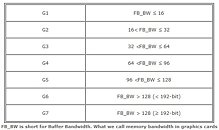Sunday, October 14th 2012
New EU Energy Guidelines Could Cripple High-End Graphics Cards
One of the biggest consumer electronics markets, EU strictly regulates materials, radio-emissions, and energy-efficiency of consumer electronics items eligible for sale in its member states. A new such energy-efficiency regulation is taking shape that specifically mandates integrated graphics cores and discrete graphics cards to live up to certain energy standards. This has GPU maker AMD worried that it could affect next-generation chips, as they could be barred from sales in the EU.
The EU classifies graphics cards on the basis of on-board memory bandwidth, which is a reliable means of segregating the various market segments. The various classes are tabled below. The top tier "G7" is classified as graphics cards with 128 GB/s or above memory bandwidth. EU wants to cap graphics cards from achieving bandwidths above 320 GB/s (possible with 6.67 GHz at 384-bit width, or 5.00 GHz at 512-bit width). The EU sees memory bandwidth as proportionate to power-consumption. It's possible that the EU sees today's hardware more than sufficiently fast to handle games, and every new generation that increases performance does so with increases in power-consumption. With the sheer size of the EU market, GPU makers could be deterred from making low-volume high-performance products for the rest of the world as well.
Source:
NordicHardware
The EU classifies graphics cards on the basis of on-board memory bandwidth, which is a reliable means of segregating the various market segments. The various classes are tabled below. The top tier "G7" is classified as graphics cards with 128 GB/s or above memory bandwidth. EU wants to cap graphics cards from achieving bandwidths above 320 GB/s (possible with 6.67 GHz at 384-bit width, or 5.00 GHz at 512-bit width). The EU sees memory bandwidth as proportionate to power-consumption. It's possible that the EU sees today's hardware more than sufficiently fast to handle games, and every new generation that increases performance does so with increases in power-consumption. With the sheer size of the EU market, GPU makers could be deterred from making low-volume high-performance products for the rest of the world as well.

35 Comments on New EU Energy Guidelines Could Cripple High-End Graphics Cards
Desktop Computer Energy Consumption - by NRDC, CLASP & ECOVA. According to the study, data was gathered to support the establishment of effective energy consumption allowances (or “adders”) for graphics cards in the Version 6.0 ENERGY STAR computer specification.
The study does talk about the link between bandwidth & energy consumed.. I just googled this study and still in the process of absorbing it..
Here is the link to the study:
www.clasponline.org/ResourcesTools/Resources/StandardsLabelingResourceLibrary/2012/~/media/Files/SLDocuments/2012/DesktopGraphicCardReport/Impact-of-Graphics-Cards-on-Desktop-Computer-Energy-Consumption_Report.pdfwhile i hope the market for high-end cards is not crippled.. high time for game developers to improve effciency / reduce overhead on software side?
:toast:
Wont allow Joe down the road to buy a high performance graphics card.
FFS.
Joe wants the biggest and best computer he can get, because his epeen isn't large enough.
Not the best comparison but the EU are doing cuts everywhere. It's actually quite surprising that they just ban it outright rather than levying a tax for it.
EU is just "forcing" consumers to buy mid-range gfx cards on a quicker cycle rate. BS.
Why won't the EU restrict politician's mouths so that they spew out less garbage and work more efficiently.